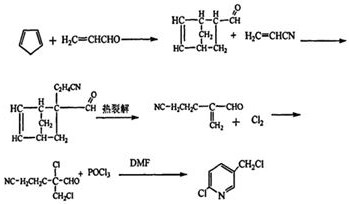Treatment method of 2-chloro-5-chloromethylpyridine production wastewater
A technology of chloromethylpyridine and treatment method, which is applied in the field of treatment of 2-chloro-5-chloromethylpyridine production wastewater, can solve problems that have not been effectively solved, and achieve resource utilization, good industrialization promotion value, and significant Effects of Economic and Environmental Benefits
- Summary
- Abstract
- Description
- Claims
- Application Information
AI Technical Summary
Problems solved by technology
Method used
Image
Examples
Embodiment 1
[0040] The waste water used in the embodiment is taken from the 2-chloro-5-chloromethylpyridine production waste water (cyclopentadiene route synthesis route) of a chemical enterprise in Gansu. The water quality is as follows in Table 1:
[0041] Table 1 Wastewater Composition
[0042] project color pH COD (mg / L) Cl- (mg / L) Ammonia nitrogen (mg / L) Total nitrogen (mg / L) Inorganic phosphorus (mg / L) other CCMP hydrolysis wastewater Red Brown 0.5 194432 99582 20317 22271 15363 H+: 3.2mol / L CCMP alkaline washing water brown 6-7 158720 24895 203 3421 156 Salt content: 5%
[0043] Such as figure 1 process shown.
[0044] The first step is to remove phosphorus by crystallization and recover trisodium phosphate. Take 20L of CCMP hydrolysis wastewater, add 4.5L of 32% sodium hydroxide, adjust the pH to alkaline, stir evenly, send it to a cooling crystallizer to cool down, crystallize at -5°C for 2h, take out the solid-liquid ...
Embodiment 2
[0052] The used waste water of embodiment 2 is identical with embodiment 1.
[0053] The first step is to remove phosphorus by crystallization and recover trisodium phosphate. Take 20L of CCMP hydrolysis wastewater, add 6.5L of sodium carbonate with a mass fraction of 20% and 2L of 32% sodium hydroxide, adjust the pH to alkaline, stir evenly, send it to a cooling crystallizer to cool down, and crystallize at 0°C for 3 hours , take out the solid-liquid separation, recover and obtain 3.1 kg of trisodium phosphate dodecahydrate, and the filtrate goes to the next step for processing.
[0054] The water quality of the filtrate was tested, and the COD was 78219mg / L, and the COD removal rate was 59.8%; the inorganic phosphorus content was 1020 mg / L, and the removal rate was 93.4%.
[0055] In the second step, high-temperature hydrolysis recovers dimethylamine. Take the filtrate after crystallization and phosphorus removal in the previous step, add 5.5L of sodium hydroxide solution ...
Embodiment 3
[0061] The waste water used in the embodiment is taken from the 2-chloro-5-chloromethylpyridine production waste water (cyclopentadiene route synthesis route) of a chemical enterprise in Shandong. The water quality is as follows in Table 2:
[0062] Table 2
[0063] project color pH COD (mg / L) Cl- (mg / L) Ammonia nitrogen (mg / L) Total nitrogen (mg / L) Inorganic phosphorus (mg / L) other CCMP hydrolysis wastewater Red Brown 0.5 305555 127638 44427 44530 32740 H+: 4.7mol / L CCMP alkaline washing water brown 6-7 93650 18357 283 327 230 Salt content: 3%
[0064] The first step is to remove phosphorus by crystallization and recover trisodium phosphate. Take 20L of CCMP hydrolysis wastewater, add 4.5L of sodium carbonate with a mass fraction of 20% and 4.5L of 32% sodium hydroxide, adjust the pH to alkaline, stir evenly, send it to a cooling crystallizer to cool down, and crystallize at 6°C After 1 hour, the solid-liquid separa...
PUM
 Login to View More
Login to View More Abstract
Description
Claims
Application Information
 Login to View More
Login to View More - R&D
- Intellectual Property
- Life Sciences
- Materials
- Tech Scout
- Unparalleled Data Quality
- Higher Quality Content
- 60% Fewer Hallucinations
Browse by: Latest US Patents, China's latest patents, Technical Efficacy Thesaurus, Application Domain, Technology Topic, Popular Technical Reports.
© 2025 PatSnap. All rights reserved.Legal|Privacy policy|Modern Slavery Act Transparency Statement|Sitemap|About US| Contact US: help@patsnap.com


